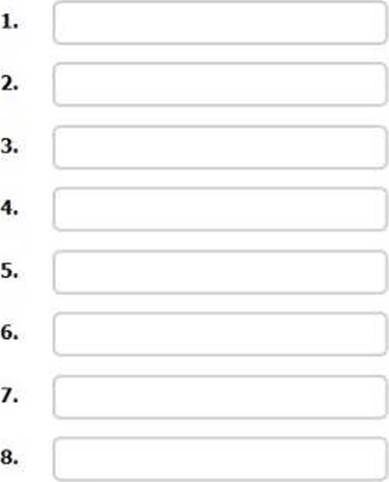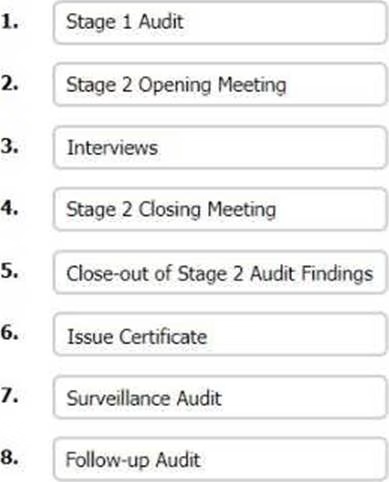Put the following steps of a third-party audit into the correct sequence in which they happen
DRAG DROP
Put the following steps of a third-party audit into the correct sequence in which they happen.

To complete the sequence click on the blank section you want to complete so it is highlighted in red and then click on the applicable text from the options below. Alternatively, drag and drop the options to the appropriate blank section.

Answer: 
Explanation:
Sequence:
Stage 1 Audit
Stage 2 Opening Meeting
Interviews
Stage 2 Closing Meeting
Close-out of Stage 2 Audit Findings
Issue Certificate
Surveillance Audit
Follow-up Audit
To complete the sequence, you can drag and drop the options to the appropriate blank section.
Here is a brief explanation of each step:
Stage 1 Audit: This is the initial audit that aims to assess the readiness of the organization for the stage 2 audit. It involves reviewing the documentation of the quality management system, evaluating the scope and objectives of the audit, and identifying any major gaps or nonconformities34.
Stage 2 Opening Meeting: This is the meeting that marks the start of the stage 2 audit. It involves confirming the audit plan, the audit criteria, the audit scope, and the audit team. It also provides an opportunity for the auditee to ask any questions or raise any concerns34.
Interviews: This is the main activity of the stage 2 audit, where the audit team collects evidence by interviewing the personnel involved in the quality management system, observing the processes and activities, and examining the records and documents. The audit team uses various techniques, such as sampling, measurement, analysis, and evaluation, to verify the conformity and effectiveness of the quality management system345.
Stage 2 Closing Meeting: This is the meeting that marks the end of the stage 2 audit. It involves presenting the audit findings, the audit conclusions, and the audit report to the auditee. It also provides an opportunity for the auditee to provide feedback, ask questions, or dispute any findings34.
Close-out of Stage 2 Audit Findings: This is the process of verifying that the auditee has taken appropriate corrective actions to address any nonconformities or opportunities for improvement identified during the stage 2 audit. The audit team may request evidence or conduct a follow-up visit to confirm the effectiveness of the corrective actions34.
Issue Certificate: This is the process of issuing a certificate of conformity to the auditee, if the audit team is satisfied that the quality management system meets the requirements of the standard and that there are no major nonconformities or unresolved issues. The certificate is valid for a specified period, usually three years, and is subject to periodic surveillance audits34.
Surveillance Audit: This is the process of conducting periodic audits, usually once a year, to monitor the continued conformity and effectiveness of the quality management system. It involves reviewing the changes, improvements, and performance of the quality management system, and identifying any new nonconformities or opportunities for improvement34.
Follow-up Audit: This is the process of conducting an additional audit, usually in response to a significant change, a complaint, or a major nonconformity, to verify the impact and the corrective actions taken by the auditee. It may result in the suspension, withdrawal, or renewal of the certificate, depending on the outcome of the audit34.
Latest ISO-9001 Lead Auditor Dumps Valid Version with 110 Q&As
Latest And Valid Q&A | Instant Download | Once Fail, Full Refund

